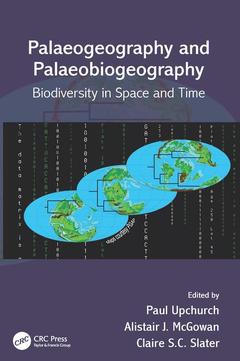Palaeogeography and Palaeobiogeography: Biodiversity in Space and Time Systematics Association Special Volumes Series
Coordonnateurs : Upchurch Paul, McGowan Alistair J., Slater Claire S.C.

Biogeography represents one of the most complex and challenging aspects of macroevolutionary research, requiring input from both the earth and life sciences. Palaeogeographic reconstruction is frequently carried out by researchers with backgrounds in geology and palaeontology, who are less likely to be familiar with the latest biogeographic techniques: conversely, biogeographic methods are often devised by neontologists who may be less familiar with the fossil record, stratigraphy, and palaeogeography. Palaeogeography and Palaeobiogeography: Biodiversity in Space and Time bridges the gap between these two communities of researchers, who work on the same issues but typically use different types of data.
The book covers a range of topics, and reflects some of the major overall questions in the field such as:
- Which approaches are best suited to reconstructing biogeographic histories under a range of circumstances?
- How do we maximize the use of organismal and earth sciences data to improve our understanding of events in earth history?
- How well do analytical techniques devised for researching the biogeography of extant organisms perform in the fossil record?
- Can alternative biodiversity metrics, particularly those based on morphological measurements, enhance our understanding of biogeographic patterns and processes?
This book approaches palaeobiogeography with coverage of technological applications and detailed case studies. It spans a wide selection of overlapping and integrative disciplines, including evolutionary theory, vicariance biogeography, extinctions, and the philosophical aspects of palaeogeography. It also highlights new technological innovations and applications for research. Presenting a unique discussion of both palaeogeography and palaeobiogeography in one volume, this book focuses both historically and philosophically on the interface between geology, climate, and organismal distribution.
Biogeographical Convergence and Time-Slicing: Concepts and Methods in Comparative Biogeography. Phylogenetic Methods in Palaeobiogeography: Changing from Simplicity to Complexity Without Losing Parsimony. Uncertainties in Phanerozoic Global Continental Reconstructions and Their Biogeographical Implications: A Review. Boundaries and Barriers of North American Warm Deserts: An Evolutionary Perspective. Integrating GIS and Phylogenetic Biogeography to Assess Species-Level Biogeographic Patterns: A Case Study of Late Devonian Faunal Dynamics. A Case Study of the Palaeobiogeography of Early Mesozoic Actinopterygians: The Family Ptycholepidae. Disparity as a Complement to Taxonomy and Phylogeny in Biogeographic Studies: Present and Past Examples from the Cephalopods.
Dr. Paul Upchurch
Dr. Alistair J. McGowan, FGS is currently based in the School of Geographical and Earth Sciences, University of Glasgow, funded by a Royal Society of Edinburgh/Scottish Government Postdoctoral Fellowship co-funded by Marie Curie Actions. He commenced his academic career as a geologist upon graduating from the University of Glasgow in Geology and Applied Geology in 1994. After three years of assorted jobs, including rebuilding a wooden boat in the most remote peninsula on mainland Scotland, mountain footpath construction, and streetsweeping, he returned to academia in 1997 to study for a M.Sc. in Palaeobiology at the University of Bristol, where his interests in quantitative palaeobiology were able to develop. This led to five years in the Department of Geophysical Sciences at the University of Chicago, where he completed his Ph.D. in 2003. Hence, although he is 39, he is only 34 in UK postdoc years. After a short spell at the Smithsonian National Museum of Natural History, he returned to the UK to work with Paul Upchurch at UCL on a biogeographic simulation project as
Date de parution : 10-2016
15.6x23.4 cm
Disponible chez l'éditeur (délai d'approvisionnement : 14 jours).
Prix indicatif 61,25 €
Ajouter au panierDate de parution : 11-2011
Ouvrage de 384 p.
15.6x23.4 cm
Thèmes de Palaeogeography and Palaeobiogeography: Biodiversity in... :
Mots-clés :
Historical Biogeography; Taxon Area Cladogram; Boundaries and Barriers of North American Warm Deserts: An Evolutionary Perspective; Cladistic Biogeography; Biogeographical Convergence of Time-Slicing; Van Der Voo; Integrating the GIS and Phylogenetic Biogeography to Assess Species-Level Biogeographical Implications; Early Triassic; A Case Study of the Palaeobiogeography of Early Mesozoic Actinopterygians; Palaeobiogeographic Analysis; Disparity as a Complement to Taxonomy and Phylogeny in Biogeographic Studies; Vicariance Biogeography; Late Devonian; Euler Pole; Comparative Biogeography; Chihuahuan Desert; North American Deserts; Palaeomagnetic Pole; Endemic Taxa; Palaeomagnetic Data; Biogeographic Patterns; Salton Trough; Endemic Genera; Early Middle Triassic; Ancient DNA; Sonoran Desert; Baja California; Tethyan Realm; Early Mesozoic; Sierra Madre Occidental



